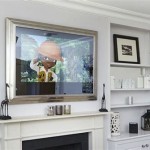Screen Mirroring From TV to Phone: A Comprehensive Guide
Screen mirroring, a technology enabling the replication of a device's display onto another screen, has become increasingly prevalent in modern digital environments. While traditionally associated with projecting phone content onto a larger television, the reverse—mirroring a TV screen onto a phone—presents unique advantages and applications. This article explores the functionalities, methods, benefits, and potential drawbacks of screen mirroring from a TV to a phone.
The core concept involves capturing the visual output of the television and transmitting it wirelessly or via a wired connection to the mobile phone. This enables users to view the TV content on their smaller, more portable device. The technology leverages various communication protocols and software applications to achieve seamless screen replication.
Understanding the Underlying Technologies
Several technologies facilitate screen mirroring from a TV to a phone. The specific technology employed depends on factors such as the TV's and phone's capabilities, the desired level of interactivity, and the available network infrastructure.
Wi-Fi Direct:
This standard allows devices to establish a direct Wi-Fi connection without requiring a traditional wireless network. It facilitates high-bandwidth communication suitable for real-time video streaming, making it a practical solution for screen mirroring. Many smart TVs and smartphones support Wi-Fi Direct, simplifying the connection process.Miracast:
Built upon the Wi-Fi Direct foundation, Miracast is a wireless display standard designed specifically for screen mirroring. It is supported by numerous Android devices and Windows computers. Miracast eliminates the need for cables and allows for the transmission of audio and video content at a relatively high quality. However, its performance can be affected by network interference and distance.DLNA (Digital Living Network Alliance):
While not strictly a screen mirroring technology, DLNA allows devices on the same network to share media files. Some applications may utilize DLNA to stream video content from the TV to the phone, effectively achieving a similar outcome to screen mirroring, particularly for pre-recorded media rather than real-time display replication.Proprietary Protocols:
Many TV manufacturers have developed their own screen mirroring protocols, often integrated within their smart TV ecosystems. These protocols may offer enhanced performance or features specific to the brand's devices. Examples include Samsung's Smart View and Sony's Screen Mirroring. However, these protocols are typically limited to use between devices of the same brand.HDMI Adapters and Capture Cards:
For situations where wireless screen mirroring is not feasible or desired, HDMI adapters can be used to connect the TV to a capture card. The capture card, in turn, connects to the phone (often via USB) and allows the phone to display the TV's HDMI output. This method typically involves a minimal amount of added latency, depending on the specifications of the capture card.Methods for Mirroring TV to Phone
The actual procedures for screen mirroring from a TV to a phone vary based on the selected technology and the specific devices involved. However, several common methods apply across different scenarios:
Using Built-in Screen Mirroring Features:
Most modern smart TVs and smartphones offer built-in screen mirroring functionality. To use this method, users typically access the TV's settings menu and enable screen mirroring. On the phone, they would then search for available devices and select the TV. This approach is often the most straightforward, especially when both devices support the same screen mirroring protocol, such as Miracast.Employing Third-Party Applications:
Numerous third-party applications are available in app stores designed to facilitate screen mirroring. These apps often provide additional features or support for devices that lack native screen mirroring capabilities. Popular apps include AirDroid, TeamViewer, and Vysor. It's essential to research and choose a reputable app that prioritizes security and privacy.Utilizing HDMI Adapters and Capture Cards:
When wireless mirroring options are limited or unsatisfactory, HDMI adapters and capture cards provide a wired alternative. Users connect the TV's HDMI output to the capture card input. The capture card then connects to the phone via USB. Software on the phone is required to display the video feed from the capture card. This approach provides more reliable and responsive screen mirroring through a non-wireless protocol.Leveraging Cloud-Based Services:
Some cloud-based services offer screen mirroring functionality. These services typically require installing an app on both the TV and the phone and connecting both devices to the internet. The service then streams the TV's content to the phone. While convenient, this method is subject to internet bandwidth limitations and potential security considerations.Each mirroring method has its nuances. For example, using Miracast requires both TV and phone to support the technology, frequently necessitating updates to the devices to ensure compatibility. Conversely, using a capture card requires additional hardware purchases but can offer more robust performance for tasks requiring low latency.
Benefits and Drawbacks of TV to Phone Screen Mirroring
Mirroring a TV screen onto a phone offers several potential benefits, but also comes with certain limitations.
Increased Mobility and Convenience:
The primary benefit is the ability to view TV content on a portable device. The user can move around the house or even outside (with a portable power source and sufficiently strong Wi-Fi coverage) while continuing to watch their shows or play video games. This offers a significantly greater degree of flexibility compared to being confined to the immediate vicinity of the TV.Private Viewing:
Screen mirroring to a phone facilitates private viewing scenarios. When others in the room are engaged in different activities, the user can watch the TV content on their phone without disturbing them. This offers a more personalized entertainment experience.Remote Monitoring and Control:
In certain contexts, screen mirroring from a TV to a phone can be used for remote monitoring and control. For example, a user might stream security camera footage from the TV to their phone to keep an eye on their home while away. This functionality provides increased peace of mind.Gaming Applications:
Gamers can leverage the technology to monitor a game that is being played on a TV while they themselves must be located elsewhere. This can provide real time updates on ongoing game progress.Potential Drawbacks
Despite the benefits, potential drawbacks need consideration.Latency Issues:
Depending on the screen mirroring method and network conditions, latency (delay) between the TV and the phone can be a significant issue. High latency can make interactive applications, such as gaming, virtually unplayable. It also disrupts the viewing experience for fast-paced content, such as sports.Battery Consumption:
Screen mirroring is a resource-intensive process that can significantly drain the phone's battery. Prolonged screen mirroring sessions may require the phone to be connected to a power source. This can reduce the portability benefit.Security Concerns:
Screen mirroring over Wi-Fi or the internet introduces potential security risks. Unauthorized access to the screen mirroring connection could allow others to view or control the TV content. It's imperative to use secure screen mirroring protocols and to avoid sharing the connection details with untrusted individuals or devices.Compatibility Issues:
Compatibility problems between the TV and the phone are possible, especially when using proprietary screen mirroring protocols or older devices. It's important to verify compatibility before attempting to mirror the screen.Resolution and Image Quality Degradation:
Streaming the display of a TV screen onto a phone may lower the original resolution quality of the television’s display. This degradation is influenced by the capability of the connectivity technology as certain methods are more capable of delivering lossless mirroring.The effectiveness of screen mirroring from a TV to a phone is heavily dependent on the individual’s tech needs, capabilities of the hardware, and security protocols in place. A thoughtful evaluation of all factors is necessary for a successful implementation of the technique.

What Is Screen Mirroring And How Do I Use It With My Samsung Tv Mobile Device

Wirelessly Mirror Any Tv Screen On Android Phone
Screen Mirroring Cast To Tv Apps On Google Play
Screen Mirroring Cast To Tv Apps On Google Play
Screen Mirroring Cast To Tv Apps On Google Play

How To Enable Screen Mirroring On A Samsung Galaxy Device

Top 3 Ways To Screen Mirror Android Sony Tv

How To Mirror Samsung Galaxy Phone A Smart Tv Guiding Tech
Screen Mirroring Sharing Apps On Google Play

How Does Screen Mirroring Work Iphone Ipad Mac Android








